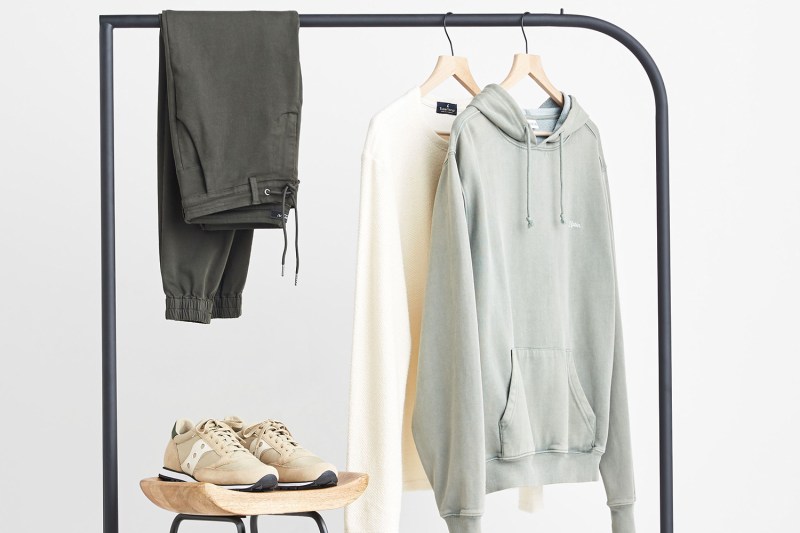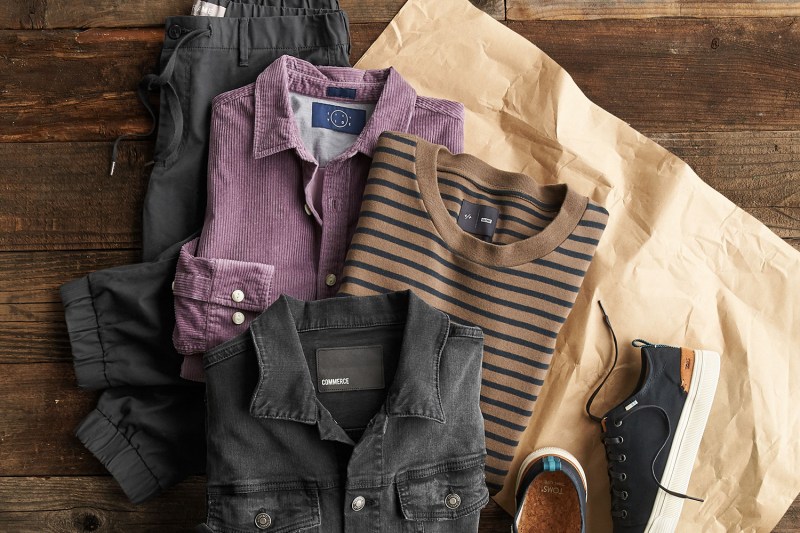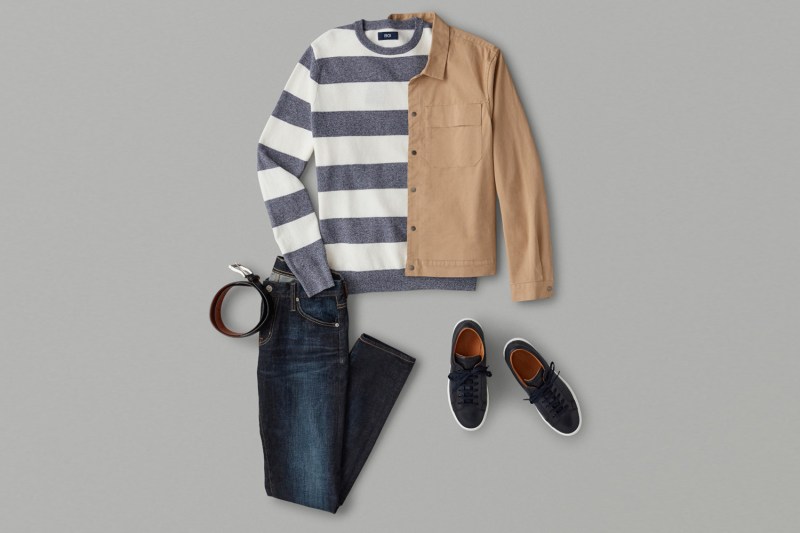In our previous reality, we woke up early, commuted, and showed up professionally groomed and dressed for our nine-to-five office jobs. But since government-enforced social distancing and self-quarantining have become an everyday phenomenon, many of us suddenly needed wardrobe assistance to adjust to our new normal. The clothes we’d worn for the occasional sick day were barely a consideration before when we’d defaulted to cozy pajamas or sweats.
Now our uniforms of freshly pressed woven shirts and dressy chinos — to say nothing of crisply tailored suits and ties — feel out of place at the kitchen table or on the living room sofa. The fact that many of us are suddenly contending with kids sent home from school indefinitely complicates matters further. Where could we call for style assistance in the age of working remotely? Turns out, men across the country are turning to virtual stylists for much-needed advice on looking camera-ready for video conference calls.
We turned to stylists Mark Smaglinski of Trunk Club and Layne Cross of Stitch Fix, the two leading personal style services, to get their perspective on the work-from-home situation.

“I definitely had people specifically asking about what they should wear during these unprecedented times,” Mark Smaglinski, a Chicago-based stylist at Trunk Club, tells The Manual. “And we have answers! I think a lot of people are excited to get something in the mail and try on new clothes, especially since they’re not leaving the house. It breaks up the monotony since they can’t go to a store and it gives them something to look forward to.”
Cross, who’s based in Capitola, California, has also recently received inquiries from style-conscious men about their work-from-home fits.
“One client said he’d like … stretchy pants, socks, and joggers,” Cross tells The Manual. “Those are the perfect items for a ‘business on the top, party on the bottom’ look. Other clients have been concerned about finding a balance between comfort and professionalism. I recommend they look to their elevated weekend-wear favorites; such as long sleeve polos, half-zip sweaters, and cardigans over freshly washed tees … I like to recommend menswear brands like Faherty, Todd Snyder, and Alternative Apparel.”
How Virtual Styling Works
Both style services start by having potential customers complete a brief survey about the kinds of clothes they wear. How much money they normally spend? Where they usually shop? Do they like shopping or putting outfits together? What brought them to the service’s website in the first place? Once the service has an idea of a client’s parameters, he is assigned to a stylist who can work with him on a one-on-one basis to get new clothes sent to him on a regular basis (in these cases, Cross’ “Fix,” or a “Trunk” for Smaglinski’s clients). The client can keep what he likes, and return what he doesn’t. The stylist then continues to follow up with the client from time to time, building on that wardrobe foundation, offering advice on how to put things together, and helping out with special occasions like weddings, work functions, or the occasional global health crisis.
Styling for Working Remotely
Although your routine is proceeding in a more relaxed environment, our experts agree that it’s important to maintain a sense of going to work. Take a shower. Eat breakfast. Shave. Choose an outfit that makes you feel like you’re working and not just lounging around the house on a Saturday afternoon.

“I think it’s very important to still have a ‘work wardrobe,’ so that you feel like you’re working,” says Smaglinski. “I’ve read that it’s a great idea to have a dedicated space for work in your home where you can feel focused; rather than being on your couch or laying in bed with your laptop. The same goes for your wardrobe. Don’t wear the same sweatshirt you wear for mowing the lawn. Wear something that’s going to help you get into the mindset of being at work. These can still be in comfortable, stretchy fabrics so you’re not distracted by what you’re wearing. You should feel just as relaxed as you would have in your favorite pair of sweatpants, but be able to stay in work mode.”
Smaglinski recommends premium denim with stretch. You’ll be comfortable, but ready to tackle the day in a professional way.
“Most of my clients are looking for styling advice on how to balance comfort and WFH-appropriate attire,” says Cross. “Those who normally work in more formal office environments are opting for polos or pullovers, as opposed to button-downs and blazers. When styling clients, I recommend five-pocket stretch chinos from brands like Theory or Mavi, which offer a great balance of comfort and professionalism.”
How to Look Camera-Ready
As Cross alluded to earlier, depending on your career, you may also suddenly find yourself ready for your close-up, appearing on video conferencing platforms like Zoom or Ring Central. Some of us are also doing more one-on-one FaceTime or Skype calls as we attempt to make our virtual relationships stronger by moving beyond voice to video communications. What’s the best way to make an impression when you’re no longer appearing in the flesh?
“While there are no particular rules when it comes to dressing for video calls, I suggest opting for rich hues and avoiding busy patterns,” Cross says. “It’s important to remember that a digital meeting should be taken as seriously as those typically held in the office, so a distraction-free environment is a must … Avoid wearing ‘loud’ fabrics; like nylon, that has the potential to rustle, and cause a distraction with every movement … You are still showing up for work, so opting for relaxed-yet-polished styles like classic knits and fresh t-shirts are ideal.”
Smaglinski also notes that these different platforms open the door to new dress codes. But even with all of these changes, he says to stick to the basics when planning your new wardrobe.
“You don’t want the outfit to take attention away from your talking head,” he says. “You still have to look professional, but you don’t necessarily want to be wearing a sport coat inside your home. Swap it out for a cardigan, or a soft knit jacket.”

During our Zoom interview Smaglinski wore a great-looking style he called a “swacket,” which was an unstructured jacket that was knit like a sweater. “It doesn’t feel like I’m wearing a jacket at all,” he commented. “It’s akin to wearing a hoodie, but it doesn’t look like it.”
With all of this talk about video, we wondered if this were part of the stylists’ every day?
“It is definitely an option,” says Smaglinski. “Once the customer gets his trunk and tries things on, they’re welcome to send us snapshots or do a video conference to show how things fit. Obviously that’s not a necessity every single time because your dedicated stylist gets to know you and your preferences; what brands work, what cuts worked best, and so on. It’s not necessary to check in every time, but it’s especially good for special occasions. We can make sure it fits right, help put an outfit together with accessories, and give them the complete look.”
Prepare for Sartorial Accidents
You may have already seen some of the funny or downright embarrassing moments that WFH-ers have been sharing on social media as we all get used to this new way of working. Smaglinski shares the story of one client who was having a video conference call at home.
“The door swung open and his little two-year-old stumbled into the room and started doing a little dance, then her baby brother joined in. The guy didn’t flinch, and continued with his conference, and eventually, his wife ran in and grabbed the kids. Of course, it went viral. Later he admitted that the real reason he didn’t get up to corral the kids was because he was wearing sweatpants under the jacket and dress shirt, and didn’t want anyone to know. I thought, well that’s a good lesson! You never know when you might have to get up so absolutely complete your outfit.”
Post-WFH Style
Not to make light of a dire situation, but, as the old Persian adage goes, “This too shall pass.” Work with a stylist to make careful investments in your WFH wardrobe now, and you’ll be sure to find other uses for the styles once we can all go back to a normal schedule. WFH may become a regular thing after companies, managers, and employees see its advantages.
“Recently, several of my clients who have honed their personal style are beginning to explore the idea of trying new trends,” points out Cross, “and they aren’t going to let working from home cause them to lose their style groove.’”
“Prepare yourself for beyond this,” says Smaglinski. “If your workplace’s dress code doesn’t permit these pieces, you can have them for other off-duty occasions. These comfortable yet practical clothes also make for a great travel wardrobe.
“I’ve traveled the world since I was two years old because my dad worked for the airlines. Because he was a representative of the airline, we had to dress appropriately to get on the plane, so, to me, dressing up to fly is the norm. Obviously I want to be comfortable, too, so I incorporate a lot of those same characteristics as WFH clothes when I fly: soft fabrics; stretchy, comfortable, performance-based fabrics. Layers are key. You look great and feel comfortable. I was recently on a seven-hour flight and wasn’t bothered at all by what I was wearing. Add to that the five hours I spent at the airport once we landed and I was great with what I was wearing.”


